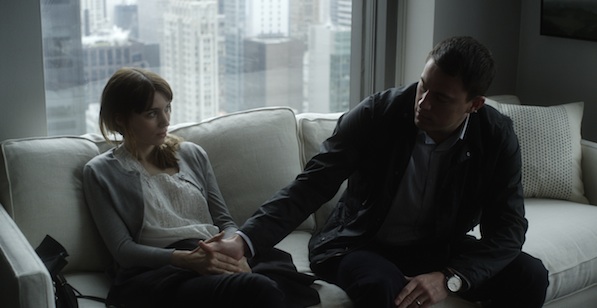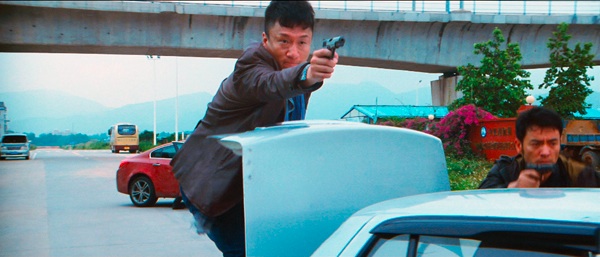
Any avid film-goer grows to appreciate the moments in movies that stand out, whether it’s for their perfect encapsulation of their creators’ larger intentions, or for the way they may exist as wonderful indulgences. It’s often little touches, or entire self-contained sequences, that keep the chase for good or great movies hopeful and engaging. (If you’re detecting a larger life metaphor here, then rest assured, it’s intentional.) Below are ten of the great movie moments this year that notably plunged us, however briefly, into the moods and interior realms of their featured characters. These scenes quietly bolster narrative, while offering the transfixing illusion of self-containment and, occasionally, of spontaneity. In these moments, we may fell as if we’re stepping off the tracks of a preordained story and plunging deeper into psyche. (Note before reading further: Spoilers aplenty.)
10. Side Effects: Martin’s murder.
This strange, disturbing fusion of satire, tormented-woman melodrama and wrong-man thriller is one of director Steven Soderbergh’s most effective films in years, and the swank charge it emits is best embodied by the surprising murder sequence that kicks off the proper plot. The timing of the appearance of the knife—dreamy, languorous, yet viciously precise (thus telegraphing, retrospectively, a later twist)—is the stuff of nightmares.
9. Drug War: Zhang’s coke-fueled undercover performance art.
The defining moment of Johnnie To’s great, relentless actioner finds ever-determined police captain Zhang (Sun Honglei) backed into a corner, forced to maintain his criminal façade while snorting what could politely be termed a prodigious amount of blow. Terrifying and hilarious, this moment is also a succinct embodiment of the film’s governing modus operandi: That action, and only action, is what ultimately defines us.
8. Post Tenebras Lux: The satyr enters.
The film is another of Carlos Reygadas’s uneven mood pieces concerned with the delicate illusions of domesticity, but at least one moment justifies the director’s wearyingly single-minded bleakness: when an animated satyr enters a family’s home, gliding through their rooms. It’s a blunt metaphor for the looming dangers ahead, as well as a bold dash of surrealism that shames the imagery of many more traditional horror filmmakers.
7. Sightseers: The end.
Ben Wheatley’s comedy of a couple driven mad by self-absorption and unresolved hatred is mounted with a chill matter-of-factness that’s often admirably difficult to take, particularly at the end, when the film dashes a (perversely qualified) potential happy ending in favor of a conclusion that pointedly leaves us with nothing, not even the comfort of the already glass-half-empty platitude “misery loves company.” Bonus points for the best use of a Frankie Goes to Hollywood song since Body Double.
6. Frances Ha: Frances running on the streets to David Bowie’s ‘Modern Love.’
It’s that simple: A pretty twentysomething woman runs down the streets of New York City as David Bowie’s “Modern Love” plays on the soundtrack. And it’s the simplicity that’s so engaging, lifting, and cathartic. Frances begins to see the livelihood inherent in her floundering, and it’s that recognition that gives her the strength to fix things. This pivotal narrative moment is deceptively stylish and tossed-off.
5. White Reindeer: Fantasia’s mother shaking her medicine at the kitchen table.
A blink-and- miss-it gesture in this film exhibits a subtle and rare understanding of the frustrations of lower-class American living. A young woman is sitting at the kitchen table hungover with her new friend, after having just corralled her young daughter into active wakefulness for the day. Barely conscious, the woman watches as her own mother shakes pills lose from her various medicine bottles in an obvious morning ritual that’s come to symbolize her feelings of regret and entrapment.
4. Gravity: The first act /the first shot.
As you probably know by now, director Alfonso Cuarón essentially covered the entire first act of his weirdly divisive space adventure in one prolonged (computer assisted) seventeen-minute take. The technological virtuosity is impressive, but it’s the primal awe that makes this opening such a stunner. Cuarón divorces you from the hurly-burly stuff of modern life and restores a sense of supernatural wonder and grandeur to pop cinema. This moment conveys a sense of authentic human humility, which seems nearly avant garde in an American media climate that relentlessly peddles self-entitlement masked as hollow self-actualization.
3. 12 Years a Slave: Hanging from a tree.
12 Years a Slave is one of the more palpable dramatizations of American slavery committed to film, a necessarily disconcerting quality that’s best embodied by the image of Solomon hanging by his neck from a tree branch, desperately wriggling his toes to the ground to keep from dying, as children play undisturbed a few feet behind him. In this image, director Steven McQueen says volumes about the insidious depths of conditioning necessary to rendering the practices of the “peculiar institution” “normal,” and of the possibilities that any inhumanity can be rendered as such, in the right social context.
2. Her: The love scene.
This year’s most stirring sex scene is an image of a blank black screen accompanied by the increasingly ecstatic moans of a man and the voice of a computer programmed to speak in the cadences of a gorgeous throaty woman. In this stylized context, director Spike Jonze captures the shock of being lonely only to discover that there’s still hope to joining love’s game. That it’s all arguably an illusion is beside the point in Jonze’s wonderful film: the emotions are the reality, and the rapid hyper-evolution of technological bric-a-brac has yet to alter that fact.
1. At Berkeley: Last dance.
Frederick Wiseman’s beautiful, despairing epic closes on a silhouette of dancers practicing an art that’s, as always, for want of funds, as Willie Nelson’s cover of “The City of New Orleans” reaches its chorus, which includes the lyrics “good morning America, how are ya?” In another director’s hands, it could be a cheap ironic jab, but we recognize that Wiseman holds out hope that his country’s still worth fighting for.
For the complete list of year-end lists on Keyframe, go to The Year in Film: 2013.
For the complete index of the films on these lists, go to 2013 Year in Review: Indexed.






